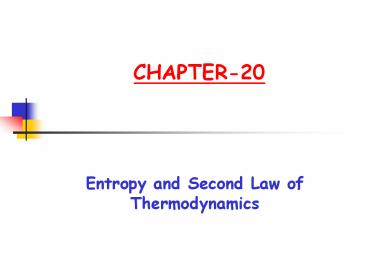Entropy and Second Law of Thermodynamics - PowerPoint PPT Presentation
Title:
Entropy and Second Law of Thermodynamics
Description:
CHAPTER-20 Entropy and Second Law of Thermodynamics CHAPTER-20 Entropy and Second Law of Thermodynamics Topics to be covered: Reversible processes Entropy The Carnot ... – PowerPoint PPT presentation
Number of Views:145
Avg rating:3.0/5.0
Title: Entropy and Second Law of Thermodynamics
1
CHAPTER-20
- Entropy and Second Law of Thermodynamics
2
CHAPTER-20 Entropy and Second Law of
Thermodynamics
- Topics to be covered
- Reversible processes
- Entropy
- The Carnot engine
- Refrigerators
- Real engines
3
Ch 20-2 Irreversible Process and Entropy
- Irreversible Process One way process
- If the irreversible process proceed in a closed
system in a reverse way, we will wonder about it.
A melted piece of ice freezes by itself. Although
from energy conservation, the process can proceed
in the reverse path i.e.heat released in in the
environment in melting ice can be recovered back
into ice piece to solidify it . Energy
conservation does not prohibit the process to
proceed one way or the reverse way. - Which parameter the one ay direction of the
process?. - Entropy set the direction of irreversible process
and irreversible process proceed through that
path in which entropy of the system always
increases - Entropy Postulate If an irreversible process
occurs in a closed system, the entropy S of the
system always increases
4
Ch 20-2 Irreversible Process and Entropy
- Change in entropy (The arrow of time)-time
reversal impossible due to entropy violation - Entropy definition Two methods
- Using systems temperature and heat loss/gain by
the system - By counting the ways in which the atoms or
molecules of the system can be arranged - Entropy S state property like P,V,T, S
- Change in entropy ?S?Q/T
- ?SSf-Si?fi ?Q/T
5
Ch 20-3 Change in Entropy
- Free Expansion of an ideal gas- Irreversible
Process - An ideal gas expands from i to f state in an
adiabatic process such that no work is done on or
by the gas and no change in the internal energy
of the system i.e. TiTf piVipfVf W?Eint0 - ?SSf-Si?fi ?Q/T
- Integral from i to f cannot be solved for an
irreversible process but can be solved for a
reversible process. - Since S is state variable (?Sif)rev (?Sif)irrev
- ?Sirrev ?Srev Sf-Si ?fi ?Q/T (irreversible)
- To find the entropy change for an irreversible
process in a closed system, replace that process
with any reversible process that connects that
connects same initial and final states and
calculate its change in entropy
6
Ch 20-3 Change in Entropy
- Calculation of Entropy in Reversible Process
- In free expansion TiTf, i.e. isothermal process
then reversible isothermal expansion process can
be used to calculate change in entropy in free
expansion. Then - ?Srev Sf-Si ?fi ?Q/T 1/T?fi?Q (isothermal)
- An ideal gas confined in a insulated cylinder
fitted with a piston . The cylinder rest on a
thermal reservoir maintained at temp T. - Gas is expanded isothermally from I to f state
and heat is absorbed by the gas from the
reservoir.?S is positive because ?Q is positive - ?S Sf-Si ??Q/T
7
Ch 20-3,4 Change in Entropy, Second Law of
Thermodynamics
- Entropy as a State function
- ?S Sf-Si ??Q/T but
- ?Eint?Q-W or ?Q ?EintW WpdV ?Eint nCV?T
- Then ?S ? ?Q/T ?if (nCVdT/T) ?if (pdV/T)
- nCV ?if (dT/T) ?if (nRdV/V)
- ?S nCV ln(Tf/Ti) nR ln(Vf/Vi)
- Second Law of Thermodynamics
- In a closed system entropy remains constant for
reversible process but it increases for
irreversible process. - Entropy never decreases
- Change in Entropy of a reversible compression of
an ideal gas in a closed system reservoir gas - ?Ssys ?Sgas ?Sres -Q/TQ/T0
8
Ch 20-5 Entropy in Real World Engines
- A Carnot engine is a device that extracts heat QH
from a reservoir at temperature TH, does useful
work W and rejects heat QL to a reservoir at
temperature TL. - On a p-V diagram Carnot cycle ( executed by a
cylinder fitted with a piston and in thermal
contact with one of two reservoirs at
temperatures TH and TL.) is bound by two
isotherms and two adiabatic.
9
Ch 20-5 Entropy in Real World Engines
- Heat QH is absorbed at Temperature TH and heat QL
is rejected at TL. - Work According to first law of thermodynamics,
?Eint?Q-W, ?Eint0 - and W?Q?QH?-?QL?
- Entropy Change ?S
- In Carnot cycle ?S0
- ?S0 QH/TH-QL/TL
- QH/THQL/TL
10
Ch 20-5 Entropy in Real World Engines
- Thermal Efficiency of an Engine ?
- ? work we get /energy we pay for
- ? ?W?/ ?QH?
- For a Carnot engine W?QH?-?QL?
- Then Carnot engine efficiency ?C is
- ?C ?QH?-?QL?/?QH?
- ?C1-?QL?/?QH?1- ?TL?/?TH?
- There is no perfect engine i.e. QL0
11
Ch 20-6 Entropy in Real World Refrigerators
12
Ch 20-6 Entropy in Real World Refrigerators
- A Refrigerator A device that uses work to
transfer energy QL from a low temperature
reservoir at temperature TL to a high-temperature
reservoir at temperature TH - Coefficient of performance of a refrigerator K
- K what we want /what we pay for
- K?QL?/?W? but W?QH?-?QL?
- K ?QL?/?W??QL?/?QH-?QL?
- K ?QL?/?QH? ?TL?/?TH?-1
- KTL/(TH-TL)
- There is no perfect refrigerator i.e. W0

